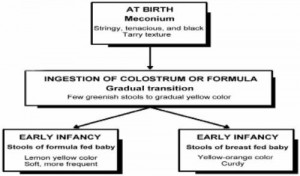a. Mouth.
The infant’s lips should be pink and the tongue smooth and symmetrical.
The tongue should not extend or protrude between the lips. The connective tissue attached to the underside of the tongue should not restrict the mobility of the tip of the tongue. The gums may have tooth ridges along them, and rarely a tooth or two may have erupted before birth.
The roof of the mouth should be closed, and the uvula should be present. Sometimes there are glistening spots (firm white or grayish-white nodules, usually multiple) on the palate that are referred to as Epstein’s pearls. A common site for them is at the junction of the hard and soft palates.
b. Stomach.
The capacity of the infant’s stomach is about one to two ounces (30 to 60 ml) at birth, but increases rapidly. Milk passes through the infant’s stomach almost immediately. The infant is capable of digesting simple carbohydrates and proteins, but has a limited ability to digests fats.
c. Intestines.
Irregularity in peristaltic motility slows stomach emptying. Peristaltic increases in the lower ileum, which results in one to six stools a day. The first stools after birth and for three to four days afterwards are called meconium. Meconium is stringy, tenacious, and black and has a tarry texture. With the ingestion of colostrum or formula, a gradual transition occurs. There may be few greenish stools and the stools will gradually become more yellow. Formula stools are lemon yellow and curdy. Breast milk stools are yellow-orange, soft, and more frequent. See figure 7-7.
NOTE: Peristalsis is referred to as progressive wavelike movement that occurs involuntarily in hollow tubes of the body, especially the alimentary canal.

